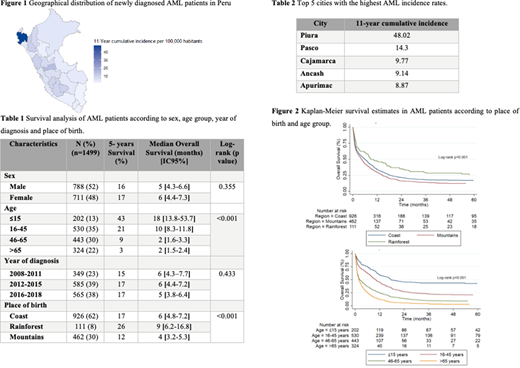Background: Acute myeloid leukemia (AML) is a highly heterogeneous disease with new cases commonly diagnosed in the elderly population. Despite advances in AML therapy, disease outcomes remain poor. Between 2010 and 2016, the reported 5-year overall survival in the U.S. was 28.7% (Source: NCI SEER 13 statistics). National based registries are vital to monitor the incidence, outcome and survivorship of AML patients. Therefore, we aim to explore the incidence and outcome of AML patients managed at the National Cancer Institute in Peru over the past decade.
Methods: We conducted a retrospective analysis of all newly diagnosed AML patients seen at the National Cancer Institute (INEN) in Lima-Peru between January 2008 to December 2018. The INEN is the major governmental leukemia center providing care for about 60% of newly diagnosed AML patients in Peru. Patient eligibility screening was performed using the Flow Cytometry Core Lab Registry. We excluded patients with acute promyelocytic leukemia. Demographic and clinical characteristics were obtained from medical records. Place of birth and death records were confirmed using the Peruvian National Registry of Identification and Civil Status (RENIEC). Survival analysis was performed using Kaplan Meier and Log-rank tests. The cumulative 11-year AML incidence rate was calculated and plotted using a choropleth map of Peru.
Results: A total of 1,499 newly diagnosed AML cases were identified and had sufficient data for analysis. Median age at diagnosis was 44 years (range: 0-92) with a female:male ratio of 0.9:1. Clinical characteristics and outcome are presented in Table 1. Twenty-two percent (n=324) of patients were older than 65 years-old at the time of diagnosis. Most patients (n=926, 62%) came from the coastal region of Peru, followed by the mountains (30%) and the rainforest (8%). The cumulative 11-year incidence rate according to geographical location is shown in Figure 1. Overall, the Peruvian hospital-based cumulative incidence rate was 4.79 AML cases per 100,000 habitants, with the highest incidence rate observed in Piura (a coastal city in Northern Peru) with 38 AML cases per 100,000 habitants. At a median follow up of 68 months, the global 5-year overall survival (OS) rate of AML cases seen in Peru was 16%. Worse survival rates were found in patients aged 66 years and older (5-year OS 3%, median survival time [MST] 2 months, p<0.001), followed by patients aged 46 to 65 years (5-year OS 9%, MST 2 months, p<0.001) (Figure 2). Better survival rates were observed in children and adolescents (5-year OS 43%, MST 18 months, p<0.001) and in patients coming from the rainforest of Peru (5-year OS 26%, MST 9 months, p<0.001) (Figure 2). No differences on survival were found when comparing by gender and year of diagnosis (Table 1).
Conclusions: This is the first study describing the incidence and outcome of AML patients in Peru. In this large contemporary cohort, we found a cumulative 11-year incidence rate of 4.79 AML cases per 100,000 habitants, with an alarming high incidence of AML cases observed in the city of Piura which needs further epidemiological evaluation. Despite improvements in supportive care in the contemporary era, our inpatient mortality for adult patients with AML remains high particularly among older patients. Further analyses are warranted to examine predictors of AML-related deaths in Peru and to develop strategies that improve patient outcomes.
No relevant conflicts of interest to declare.
Author notes
Asterisk with author names denotes non-ASH members.


This feature is available to Subscribers Only
Sign In or Create an Account Close Modal